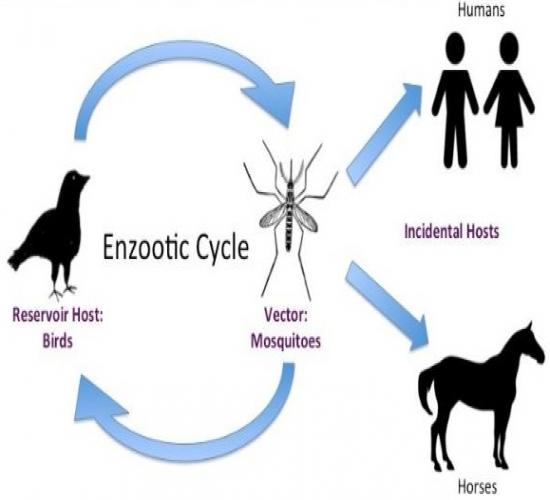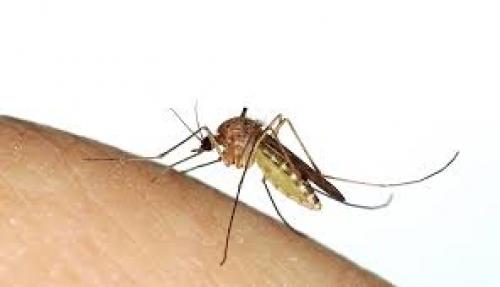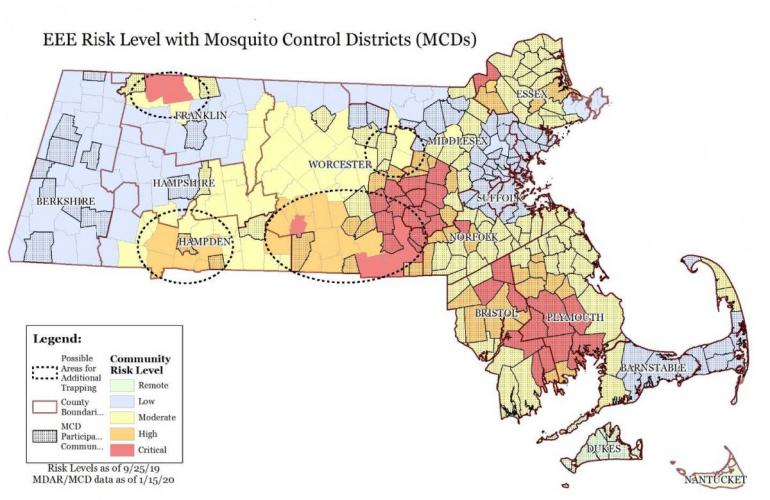Eastern Equine Encephalitis (EEE)
2020 EEE Season Updates
On August 11, a mosquito tested positive for EEE in Douglas, next to Uxbridge. EEE is in our area. Please take immediate actions to reduce mosquito bites: reduce standing water near your home, avoid going outside from dusk to dawn, and always wear mosquito repellant when you are outside!
On July 3, 2020 the first mosquitoes tested positive for EEE in Orange, Massachusetts, 50 miles northwest of Uxbridge. On July 9, 2020, State public health officials announce season’s first West Nile virus-positive mosquito sample in Belmont, MA.
On August 3, 2020 the first human case of EEE in MA was reported in Plymouth County.
Please start taking precautions against EEE tight now. For tips on preventing mosquito bites, visit our mosquito borne diseases page
If you suspect your horses or any of your other animals have EEE, you must report it to the Department of Agricultural Resources and the Department of Public Health
- You can report the suspected case to MA DAR by calling 617-626-1795
- You can report the suspected case to MA DPH by calling 617-983-6800
Overview of EEE
Eastern Equine Encephalitis is a very rare and extremely dangerous disease transmitted by mosquitoes. In the wild, EEE cycles between birds and C. melanura mosquitoes1, and is rarely transmitted to humans when a EEE-infected mosquito bites a human. In some areas where Cs. Melanura mosquitoes are prevalent, human-biting mosquitoes may become infected with EEE as well, then transmit the virus to humans. EEE is only spread from bird to mosquito to human. Humans cannot transmit EEE to other people, and a mosquito who bites an infected human will not become infected with EEE2.
Infection with the EEE virus can result in a systemic febrile illness, meningitis (the infection of areas around the brain and the spinal cord) or encephalitis, the infection of the brain. EEE is very dangerous: As many as 75% of people who are infected with it die, 30% of survivors will have long term neurologic defects3.
EEE has no effective treatments, and can be very serious. It is extremely important to prevent infection with the virus by reducing your chances of being bitten by a Culex mosquito. Some ways you can prevent EEE include removing standing water from around your house, staying inside between dawn and dusk when the mosquitoes are most active and wearing DEET-based mosquito repellant when you are outside.
For more suggestions on preventing mosquito bites, visit our Mosquito-borne Diseases page.
EEE Life Cycle
Eastern Equine Encephalitis Virus is maintained in a cycle between the Culiseta melanura species of mosquito and birds in freshwater hardwood swamps and wetlands. A mosquito becomes infected with EEE by biting an infected bird. The virus replicates in the midgut and salivary glands of the mosquito before being transmitted through the mosquito’s saliva to a bird4. The majority of birds infected with EEE do not die from it5, and gain immunity.
As more and more birds acquire immunity from EEE, the virus cannot spread as easily, and infection rates decline. Infection rates stay low until there are enough young birds to spread quickly again. This is why EEE tends to happen in 2-3 year cycles.

How EEE Spreads
EEE is spread by mosquitoes. In the wild, the virus spreads between birds and Culiseta melanura mosquitoes. Rarely, an infected mosquito will transmit the virus to another animal such as a horse or a human. Cs. melanura rarely bites humans, so it is thought that other species of mosquitoes that bite both birds and humans (such as Culex perturbans) act as a “bridge species”. While the EEE-infected mosquito is biting a human, the virus exits the mosquito’s salivary glands and gut and enters the human bloodstream.

EEE cannot be spread through coughing, sneezing or touching an infected person.
When Do Symptoms Develop?
The incubation period of EEE from bite to the first symptoms can range from 4 to 10 days. After the start of symptoms, the illness usually lasts one to two weeks, though recovery often takes much longer8.
EEE Symptoms
The severity of EEE dependents on whether the virus enters the brain or the central nervous system (CNS) If EEE virus does not enter the CNS, the illness will likely be mild. Symptoms generally include fever, chills, malaise, joint pain and muscle aches.
If the virus does enter the CNS or the brain, the EEE illness is extremely dangerous. Initial symptoms will be sudden may be fever, chills, headache, and vomiting. Symptoms may then progress into diarrhea, seizures, drowsiness and coma, and may lead to death8.
EEE Diagnosis and Treatment
EEE is most often diagnosed with a test for IgM antibodies against EEE virus in the blood. These tests are generally performed at state public health laboratories or at the CDC’s Arbovirus Diagnostic Laboratory6.
It is important to note that the virus may not be detectable by tests until a week after infection, at which time the severe symptoms may already be present7.
There are no specific treatments for EEE, and patients with the disease are limited to receive supportive care such as respiratory support, IV fluids and hospitalization8. Due to the lack of effective treatments, it is incredibly important to take steps to prevent EEE.
When to Seek Medical Attention
If you or someone you know is experiencing sudden fever, chills, headache or vomiting, contact a healthcare provider IMMEDIATELY.
EEE in Uxbridge
In 2019, Uxbridge was designated as a Critical Risk Community for EEE by the Massachusetts Department of Public Health. We had a single case of EEE in a horse, though we did not have any human cases.

Useful Links:
For information on EEE and mosquito borne diseases, you can visit the Uxbridge, MA Department of Public Health and Centers for Disease Control websites:
- Uxbridge Mosquito Borne Diseases Webpage: https://www.uxbridge-ma.gov/board-health/pages/mosquito-borne-diseases
- MA Department of Public Health: https://www.mass.gov/service-details/eee-eastern-equine-encephalitis
- CDC: https://www.cdc.gov/easternequineencephalitis/index.html?CDC_AA_refVal=https%3A%2F%2Fwww.cdc.gov%2Feasternequineencephalitis%2Ftech%2Ffactsheet.html
Works Cited:
- Mermel LA. Association of Human Eastern Equine Encephalitis With Precipitation Levels in Massachusetts. JAMA Netw open. 2020;3(1):e1920261. doi:10.1001/jamanetworkopen.2019.20261
- Transmission | Eastern Equine Encephalitis | CDC. https://www.cdc.gov/easternequineencephalitis/tech/transmission.html. Accessed June 18, 2020.
- Symptoms & Treatment | Eastern Equine Encephalitis | CDC. https://www.cdc.gov/easternequineencephalitis/tech/symptoms.html. Accessed June 18, 2020.
- Armstrong PM, Andreadis TG. Eastern equine encephalitis virus in mosquitoes and their role as bridge vectors. Emerg Infect Dis. 2010;16(12):1869-1874. doi:10.3201/eid1612.100640
- Deresiewicz RL, Thaler SJ, Hsu L, Zamani AA. Clinical and neuroradiographic manifestations of Eastern equine encephalitis. N Engl J Med. 1997;336(26):1867-1874. doi:10.1056/NEJM199706263362604
- Eastern Equine Encephalitis Virus (EEEV): the Role of Diagnostics. https://www.asm.org/Articles/2019/October/Eastern-Equine-Encephalitis-Vi.... Accessed June 18, 2020.
- Morens DM, Folkers GK, Fauci AS. Eastern Equine Encephalitis Virus — Another Emergent Arbovirus in the United States. N Engl J Med. 2019;381(21):1989-1992. doi:10.1056/NEJMp1914328
- Frequently Asked Questions | Eastern Equine Encephalitis | CDC. https://www.cdc.gov/easternequineencephalitis/gen/qa.html. Accessed June 18, 2020.
| Attachment | Size |
|---|---|
| 153.97 KB |
